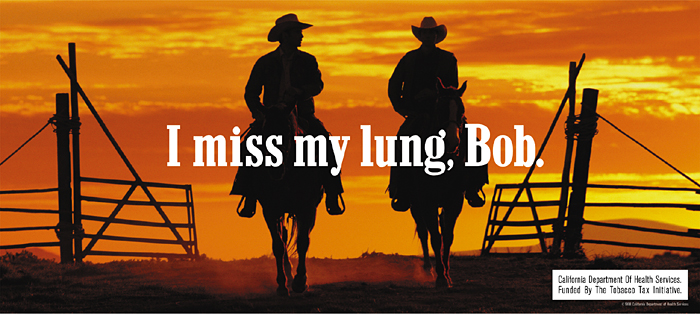No matter how much alluring imagery you use to sell them, you can't negate the truth: cigarettes are bad for you. Everyone knows this these days, thanks largely to public health campaigns. The facts slung at us day after day are mind-blowing: Every cigarette you smoke costs you 11 minutes of life; daily smokers loose on average seven years of life; half of smokers will die of smoking related disease; tobacco is the single largest cause of preventable premature death and disease in Australia.
These statistics – and I could go on – stand in stark contrast to the notions of freedom and individualism that smoking has come to represent. It’s ironic that smoking symbolises freedom when in reality you are the opposite of free: you are addicted to nicotine, you are a slave to the cigarette. The documentary Death in the West highlighted this irony by directly contrasting the Marlboro Man ads with the men who starred in them, 30 years on and all dying of lung cancer. American publication Mother Jones said it was “one of the most powerful anti-smoking films ever made. You will never see it.” That’s because Phillip Morris sued the makers and in 1979 all copies were secretly suppressed. Thankfully, we have YouTube now.
Each year, smoking kills 15,000 Australians and costs the economy $31.5 billion dollars. That’s a fairly compelling reason for the Government to launch an assault on smoking. Health warnings have been on cigarette packages since 1973, and around that time the Government ran a campaign asking school children to design posters communicating the negative health impacts of smoking. The damaging effects of smoking were beginning to be more widely known, however, despite several attempts, the majority of cigarette advertising wasn’t banned until 1992. In fact, until the mid-1980s, the Australian Open was called the Marlboro Australian Open. That’s a pretty big ad.
More recently anti-smoking ads and other government initiatives have stepped up enormously. Australia has some of the strongest anti-smoking initiatives in the world. But what really works with anti-smoking ads? What actually stops people smoking?
According to the executive director of Quit Victoria Fiona Sharkie, ads that evoke high levels of emotions tend to be the most effective. A major Australian study published by the US National Cancer Institute found that negative ads tended to be more effective than positive ads, particularly those that graphically depicted the harm caused by smoking. These ads were found to be more effective than those that tried to be funny.
However, an RMIT study from 2012 found that negative advertising and anti-smoking measures actually did not encourage young people to quit. In fact, the increasing price of cigarettes and restriction of smoking in public actually increased the desire to smoke. Positive campaigns – particularly those that used public figures expressing the positivity they experienced from quitting – were the most effective. A recent shift toward positive anti-smoking ads may reflect this finding, the 'Never Give Up Giving Up' TV commercial.
Some see plain packaging, which came into effect in December 2012, as a positive step towards reducing smoking rates. Others, including people in the advertising industry, have argued that plain packaging could work counter to its aims and give cigarettes a 'cult' status.
Martin Lindstrom’s Buyology: Truth and Lies About What We Buy, found that warning labels placed on cigarette packs had the opposite effect intended. One study found that when asked if they found warning labels effective, participants said yes. This was their conscious response. But when hooked to an fMRI scan and shown images of cigarette warning labels, craving spots became active in their brains, suggesting that the images had increased their desire to smoke. A different study found anti-smoking ads had a similar effect.
And while smoking rates are decreasing in almost all Western countries, they are rising in middle-income and poor countries. This is because big tobacco aggressively push their products on developing countries, using the Western lifestyle to sell them. They are targeting women in particular, and as a result the age women are taking up smoking is getting younger.
Rates of smoking in Australia have plummeted. In 1965 about 50 per cent of men and 33 per cent of women smoked; now about 15 per cent of the total population smokes. What role anti-smoking ads have played in this is difficult to say. But either way, I certainly enjoyed trawling through them all while researching the blog. It's a particularly fertile field: there are some great ones and some weird ones. I'll leave you with a few.
This was an anti-smoking campaign run by Hitler, often considered the first national leader to advocate non-smoking. It reads: “A chain smoker: he does not devour it, it devours him.”
The truth campaign exposes many of the manipulating things tobacco companies have done to get people to smoke. You can vote for the ugliest truth on their website: http://www.thetruth.com.
Reads: “Smoking is being a slave to tobacco.”
Beth Gibson






